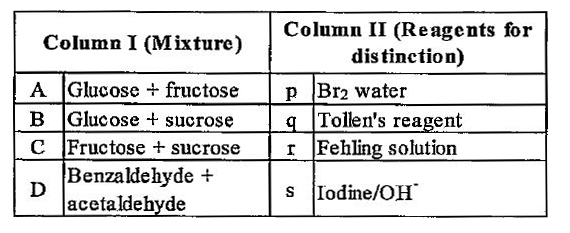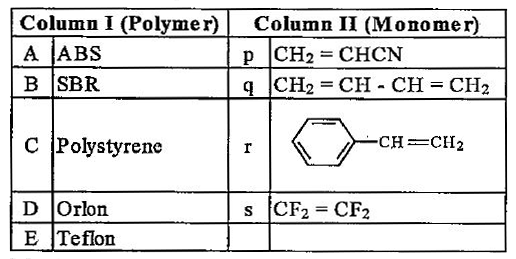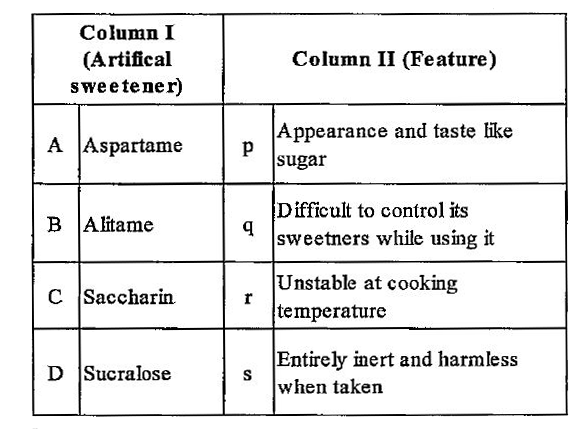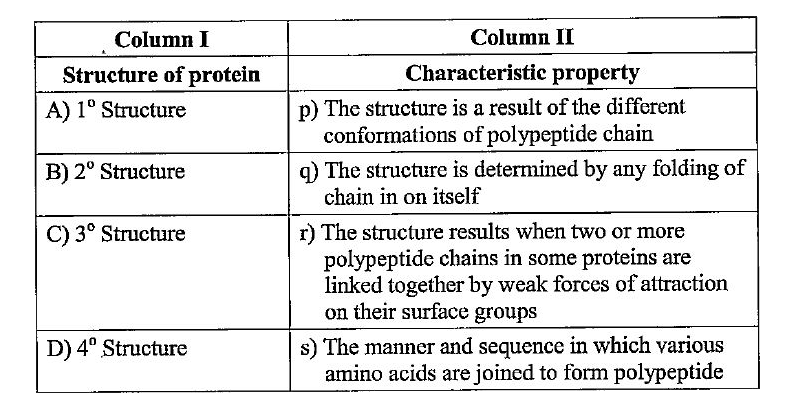LEVEL -III (Numerical Type) from BRILLIANT PUBLICATION POLYMERS, BIOMOLECULES AND CHEMISTRY IN EVERYDAY LIFE for Class 12
| Class 12 | CHEMISTRY |
| Chapter | POLYMERS, BIOMOLECULES AND CHEMISTRY IN EVERYDAY LIFE |
| BRILLIANT PUBLICATION | LEVEL -III (Numerical Type) |
| Medium | English |
| Academic Year | 2023-2024 |
Question 2
Consider the following statements about sucrose.
I. Hydrolysis of sucrose with dilute acid yields an equimolar mixture of D-glucose and D-fructose.
II. Acid hydrolysis of sucrose is accompanied by a change in optical rotation.
III. In sucrose, the glycosidic linkage is between C1 of glucose and C2 of fructose.
IV. Aqueous solution of sucrose exhibits mutarotation.
Which of the statements given above are correct?View SolutionQuestion 23
A tetrapeptide has -COOH group on alanine. This produces glycine (Gly), valine (val), phenyl alanine (Phe) and alanine (Ala), on complete hydrolysis. For this tetrapeptide, the number of possible sequencies (primary structures) with −NH2 group attached to a chiral centre is..............View SolutionQuestion 36
Statement 1: A solution of sucrose in water is dextrorotatory but on hydrolysis in presence of little hydrochloride acid, it becomes laevorotatory.
Statement 2: Sucrose on hydrolysis gives unequal amounts of glucose and fructose as a result of which change in sign of rotation is observed.View SolutionQuestion 42
Every amino acid has a carboxyl group and an amino group, and each group can exist in an acidic form or a basic form depending on the pH of the solution in which the amino acid is dissolved. The carboxyl groups of the amino acids have pKa values of approximately 2, the protonated amino group have pKa values near 9. Therefore, in a very acidic solution (pH near zero), both groups will be in their acidic forms. At a pH of 7, (which is greater than the pKa of the protonated amino group), the carboxyl group will be in its basic form and the amino group will be in its acidic form. In a strongly basic solution (say pH=11), both groups will be in the basic form.

Form A(cationic) of an amino acid exists inView SolutionQuestion 43
Every amino acid has a carboxyl group and an amino group, and each group can exist in an acidic form or a basic form depending on the pH of the solution in which the amino acid is dissolved. The carboxyl groups of the amino acids have pKa values of approximately 2, the protonated amino group have pKa values near 9. Therefore, in a very acidic solution (pH near zero), both groups will be in their acidic forms. At a pH of 7, (which is greater than the pKa of the protonated amino group), the carboxyl group will be in its basic form and the amino group will be in its acidic form. In a strongly basic solution (say pH=11), both groups will be in the basic form.

Form C(anionic) of an amino acid exists inView SolutionQuestion 45
Monosaccharides containing an aldehyde group are called aldoses while those containing aketo group are called ketoses. The aldehyde group is always present at C1 while the keto group is usually present at C2. All monosaccharides containing five and six carbon atoms have cyclic structures, furnaose (five membered) and pyranose (six membered). During ring formation, C1 in aldoses and C2 in ketoses becomes chiral and hence all these monosaccharides exist in two stereoisomeric forms called the α -anomer and the β-anomer while C1 and C2 are called glycosidic or anomeric carbon atoms. In contrast, stereoisomers, which differ in configuration at any other chiral carbon other than the glycosidic carbon are called epimers. Two molecules of the same or different monosaccharides combine together through glycosidic linkage to form disaccharides. All monosaccharides (aldoses and ketoses) and most disaccharides reduce Tollens'reagent and Fehling's solution, undergo mutarotation and form osazones.
Which of the following pairs give positive Tollens' test? View SolutionQuestion 46
Monosaccharides containing an aldehyde group are called aldoses while those containing aketo group are called ketoses. The aldehyde group is always present at C1 while the keto group is usually present at C2. All monosaccharides containing five and six carbon atoms have cyclic structures, furnaose (five membered) and pyranose (six membered). During ring formation, C1 in aldoses and C2 in ketoses becomes chiral and hence all these monosaccharides exist in two stereoisomeric forms called the α -anomer and the β-anomer while C1 and C2 are called glycosidic or anomeric carbon atoms. In contrast, stereoisomers, which differ in configuration at any other chiral carbon other than the glycosidic carbon are called epimers. Two molecules of the same or different monosaccharides combine together through glycosidic linkage to form disaccharides. All monosaccharides (aldoses and ketoses) and most disaccharides reduce Tollens'reagent and Fehling's solution, undergo mutarotation and form osazones.
Two forms of D-glucopyranose are calledView SolutionQuestion 47
Monosaccharides containing an aldehyde group are called aldoses while those containing aketo group are called ketoses. The aldehyde group is always present at C1 while the keto group is usually present at C2. All monosaccharides containing five and six carbon atoms have cyclic structures, furnaose (five membered) and pyranose (six membered). During ring formation, C1 in aldoses and C2 in ketoses becomes chiral and hence all these monosaccharides exist in two stereoisomeric forms called the α -anomer and the β-anomer while C1 and C2 are called glycosidic or anomeric carbon atoms. In contrast, stereoisomers, which differ in configuration at any other chiral carbon other than the glycosidic carbon are called epimers. Two molecules of the same or different monosaccharides combine together through glycosidic linkage to form disaccharides. All monosaccharides (aldoses and ketoses) and most disaccharides reduce Tollens'reagent and Fehling's solution, undergo mutarotation and form osazones.
Which of the following pairs give the same osazone?View Solution









